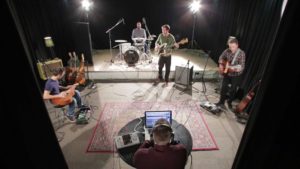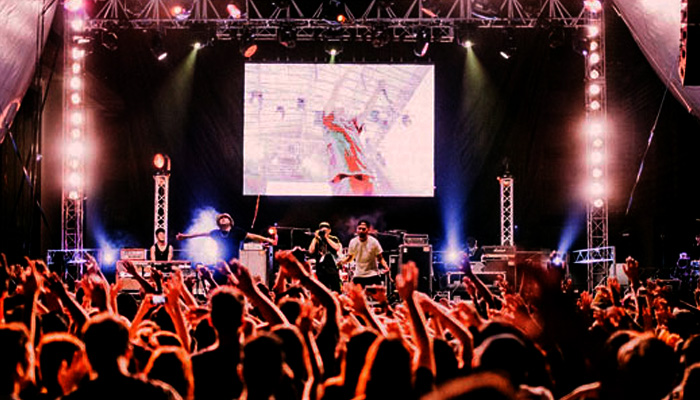by T. Perry Bowers
I’ve spent a lot of time in the recording studio working with bands. This is where I feel most at home, but over the years I’ve had many opportunities to record bands in a live performance situation. This is some of the information I’ve gathered.

Step 1: Resources
If you’re in the recording business, you may be able to convert your studio rig into a live rig. While it’s not ideal to carry your big desktop computer to a venue, in a pinch you can do it.
Remember that there is no overdubbing in a live situation, so your going to need a microphone, a cable and a stand for each instrument you plan to capture. Even for a three piece band, the input list could be quite large.
Here is an example of an input list for a live gig:
Kick
Snare
Hi-hat
High rack left
High rack right
Floor tom
Left overhead
Right overhead
Bass direct
Bass amp microphone
Left guitar
Right guitar
Acoustic guitar pre-amp
Lead vocal
Backing vocal 1
Backing vocal 2
Saxophone
Conga left
Conga right
Auxiliary percussion
Audience
So all in all, we have twenty one inputs. I could scrape together twenty one stands, cables and mics because I have a rehearsal space business, but most recording studio guys are going to need to rent some stuff.
So make a list of what you have and what you need. Make some calls to the rental places and get some rates.
Sometimes it’s great to just take a feed from the board. If you can make some sort of a deal with the venue, it could be your best option. I’ve found that trying to get an agreement with a venue can be difficult. There is no guarantee that their equipment is going to be trouble free. The sound man may be cooperative, he may not.
Sometimes live venues are all set up to make live recordings. Many live sound people run a little side business where they make a recording of a gig and charge you a few bucks. I’ve never been satisfied with these recordings. Maybe it’s because the sound engineers are trying to do two things at once and their main emphasis is on what you sound like in the room?
Some live venues won’t let you bring in your own rig. You have to use their equipment. The point is, if you don’t want to provide a completely separate recording rig, contact the venue and see when kind of a deal you can make. Check out their gear. if you can, try and hear a sample of something they have recorded.
Figure out what you need to supplement what they have.
Even if you are taking a feed from their board or you are providing all of your own microphones, you still need an interface and a recording device. If you’re a studio guy, you may have something that will work, but you’re not going to bring an entire SSL console into a small club.
You need something portable. There are some beautiful compact boards that are great for this kind of setting. Midas and Presonus are some brands you might want to check out. You can capture all of your mics and send it right to a laptop.
On your laptop (or portable desktop), you will need Pro-Tools or some other multi-tracking software. You will want some isolation headphones. This isn’t a recording studio situation where you have your musicians in a separate room. Most likely, (unless you have a mobile van or iso booth) you’ll be in the same room as the band and it will be loud. Isolation headphones will help you dial in the sound without too much bleed.
Those are the basics. Make sure you do something to protect all of your gear. Even if you can’t afford professional road cases, you can make do with the boxes in which your gear was shipped. Don’t throw all your stuff in the back of the truck unprotected. You’ll be luck if you get to the venue without something breaking. At the very least (if you don’t protect it), your stuff is going to get nicked and scratched. The road is very hard on gear.
Resources include people. For a full band setup, you may need a second or even a third person. Go through your contact and hire the best man/woman for the job.
Make sure they are trustworthy and reliable. Do they have their own transportation? Or do you need to pick them up?
If you are pooling gear resources, have them send you a check list of all the things they can provide. Bring that list with you on the day of the gig.
Step 2: Assembly
You have all the gear that you need written down on a sheet of paper. Now, it’s time to put it all together. Make sure you have enough room to transport all the gear safely to the gig.
It’s helpful for me to have a timeline on a piece of paper (or at least in my head). I usually work backwards from the time I will be arriving at the gig (with all the gear) to the time I wake up in the morning.
Make sure you have enough time to gather all the gear and arrive on time, or better yet arrive early. The band already has enough on their minds. They have to perform. They don’t need to be worrying about the recording crew being able to do their job.
Step 3: Strategy
All these steps are inter-related. You will find that you will often be doing all of these steps at the same time. I’m trying to break them down, so that you can see the key elements in your approach.
You need to have a strategy to know what kind of resources you will need. But, now that you know what you’re bringing, let’s look at strategy.
I like to work out on a timeline when I need to start packing up for the gig. When do I need to be there to have ample time to set up? I think if the day in reverse. If I need to be completely set up and off the stage by seven pm, then I wok in travel time, loading time, set up time and plenty of time for setbacks and unforeseen events. If all that will take me three hours, then I need to start loading at three pm. You get the idea.
I’m not trying to belabor the time factor only because I’m obsessed with being on time. I’m hammering on it because it is a key element to being successful doing this job. Always consider time. Don’t get spacey and let time run away from you. I find that no matter how much time I give myself for a live recording, it always disappears.
Another part of your strategy will be working with the venue and the band members. If you’re taking a feed from the house board, you won’t interfere much on stage. If you’re setting up another whole set of microphones, you’ll have to work with the band.
If you can, make sure the band leader has briefed the band on the process. You don’t want to be getting in there way when they are rushed to set up for the show. Make sure the house sound guy knows too. Don’t rely on the band to inform everyone of your presence. It will all go better if you don’t assume everyone knows what you’re doing.
If you have another person or two that is on your team. Go over your strategy with them before hand. As you get a few of these live gigs under your belt, you might not have to prep as hard. If you’re luck enough to have a reliable side man, he will get used to your flow and you won’t have to talk strategy as much. But more than likely it’ll be a different helper every time you go out. So, make a “pre-production” meeting part of your routine.
Step 4: Action
Now it’s time to do it. Get plenty of sleep. Eat a healthy meal before you start. Bring healthy snacks and liquids for the job.
Keep a good attitude. You will run into setbacks. There will be frustrations. But, never let the band know there is a problem if there is one. Don’t ever pile on to their duties to perform.
A big part of what you do as you set up is being invisible, both physically and emotionally. This is also true of being a studio engineer. Never show that you’re stressed. A good way to never show that you’re stressed is to never be stressed.
So be prepared and give yourself plenty of time.
Bonus Tip: Mic Placement and Gain Structure
If you’ve noticed, I haven’t talked much about the technical aspect of the live sound job. That’s mostly because I assume if someone is going to hire you to record their band, you must have some knowledge. But I’ll give you a few techniques that I employ.
Close mic everything. You’re going to get bleed from even instrument. If you put the mic very close to the source, you limit bleed.
Listen constantly. Don’t assume the meters are telling the whole story. Every so often, solo each track and listen for abnormalities. Crackles and pops in a lead guitar solo can ruin everything. If you do find a crackle, trouble shoot and remedy the issue immediately.
Ride the faders. I’d rather have to deal with some volume differences in the mix later than not have enough signal or deal with a bunch of clipping. Don’t be afraid to turn things up and down. If possible, make small adjustments and make them slowly. You’re driving a ship, not a race car.
Use mics without stands. Stands get in the way in a live situation. Use clip-on mics for the drums. They make guitar amp microphone clips, too. But, don’t just hang an sm57 sideways off of the top of the amp. When I see this, I think amateur. The diaphragm of the mic doesn’t move sideways. You have to point it directly (or slightly off center) at the speaker.
Set your gain structure a little lower in a live situation (as opposed to a recording studio). I’d rather have to boost a slightly soft signal, than deal with a bunch of distortion. However, with that being said, live recording is an active job. Constantly monitoring the gain structure is very important.
Always have a good stereo pair of microphones in a good position for a backup. If all else fails, you’ll still have a decent stereo recording. You can use it to supplement your multi-track set-up. You can also use it to fill in gaps if you have a mic failure or glitch.
lastly remember, you only get one chance to capture everything in a live situation. Have some back-up cables and mics on standby. Don’t just hit record and chill. Until the last note rings out, you’re on active duty.

